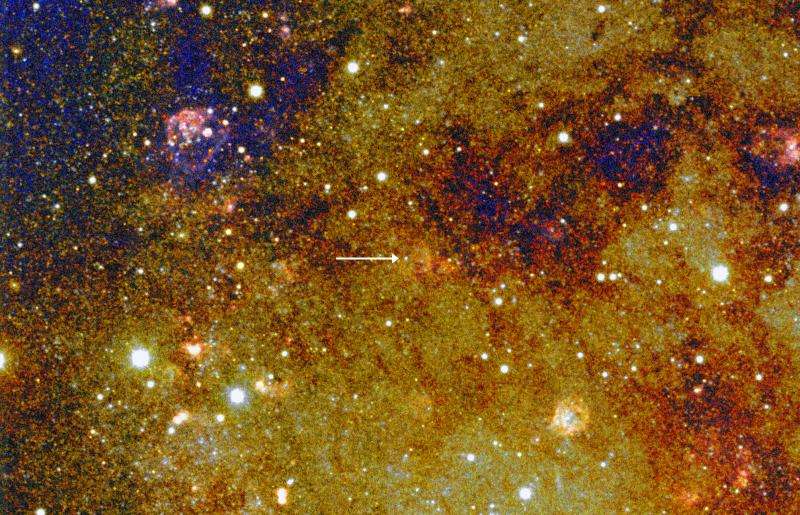A quasi-true colour Liverpool Telescope image of the region of M31 around the recurrent nova M31N 2008-12a. The yellow backdrop is the unresolved stars of M31, and the dark patches are regions of dust and gas. The bright stars seen in the image are in the foreground and belong to our own Galaxy. Marked by the white arrow, the nova can be seen in eruption in the centre of the image. Credit: M. Darnley / LJMU
Using the robotic Liverpool Telescope, an international team of scientists has found what looks like the best pre-explosion candidate yet for a 'type 1a' supernova, where a massive and extremely dense star in the Andromeda Galaxy is dragging material away from its companion. This star is set to be completely destroyed in the (astronomical) near future in a catastrophic explosion. Matt Darnley of Liverpool John Moores University presented their results today (9 July) at the National Astronomy Meeting at Venue Cymru, in Llandudno, Wales.
Our Sun is expected to have a relatively gentle end to its life. But some stars have a more violent demise in prospect – they are destined to explode as supernovae, briefly shining as brightly as a whole galaxy of stars. One class of these explosions, type 1a supernovae (SN1a), is fundamental to our understanding of the evolution of the Universe.
Some pairs of stars or binary systems are particularly close together. Where one of the stars is a white dwarf (the long extinguished superdense remnant of a star that was once similar to our Sun), and the other is a more normal companion, the gravity of the white dwarf fundamentally changes both objects. The outer atmosphere of the normal star, mostly hydrogen and helium, flows towards the white dwarf, eventually building up as a thick layer on its surface.
Under the right conditions, this material will compress and heat up enough for runaway nuclear fusion to take place, similar to that in a hydrogen bomb, but far more powerful than anything seen on Earth. This explosion is a nova – meaning 'new star' – and for a short period the system will have the brightness of between 100 and 500 thousand Suns. Some, but by no means all, of the accumulated material from the companion star will be ejected into space.
Of the 400 novae seen in our Galaxy, the Milky Way, a handful have been seen to erupt more than once. These 'recurrent novae' erupt frequently as the mass of the white dwarf is already high from the millions of years of transfer of material and its companion star is losing material at a high rate. In the Milky Way, the most active recurrent nova is U Scorpii, which erupts about once a decade.
But the cycle of explosions cannot go on for ever. Once a white dwarf accumulates close to 1.4 times the mass of the Sun – the 'critical mass' – its core temperature will have risen to around 500 million degrees (30 times hotter than the centre of the Sun). The stellar material subsequently undergoes another and much more powerful thermonuclear reaction, in an enormous explosion that destroys the white dwarf in a few seconds, releasing vast amounts of energy in the process. This is a type 1a supernova, and for a number of days it has the brightness of billions of Suns.
In 2008 scientists spotted the eruption of a star, later confirmed to be a nova, in the Andromeda Galaxy (M31), the nearest large galaxy to our own some 2.5 million light years away. Remarkably the same star, catalogued as M31N 2008-12a, erupted again in 2009, 2011, 2012, 2013 and 2014. Darnley and his team initiated a follow up programme in 2013 and 2014, using the Liverpool Telescope and X-ray observations from the orbiting Swift observatory.
Their work shows that in astronomical terms, M31N 2008-12a is on the brink of catastrophe. With explosions in rapid succession, the white dwarf must be just a fraction under the critical mass and could be torn to pieces in a supernova anytime in the next few hundred thousand years.
Darnley commented: "We've never seen anything like this before. Here is a pair of stars that release vast amounts of energy almost every year. The system is right on the cusp of total destruction, so we are getting a first look at how it is changing right before it erupts as a supernova. And that could happen tomorrow, or hundreds of thousands of years in the future – it's very much a star system to watch."
This UK and international team hope to continue to monitor M31N 2008-12a for the foreseeable future. Type 1a supernovae are all thought to have similar brightnesses, so are used as 'standard candles' to gauge the distance to galaxies and measure the properties of the Universe as a whole. Understanding systems like M31N 2008-12a is a key part of that.
Provided by Royal Astronomical Society























